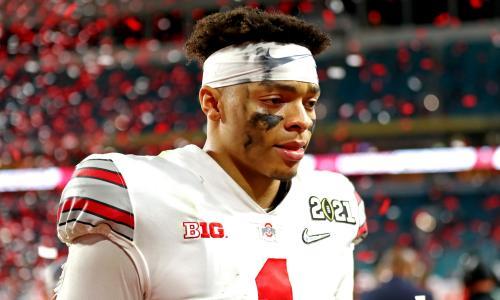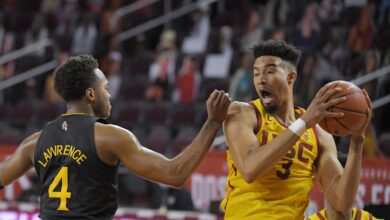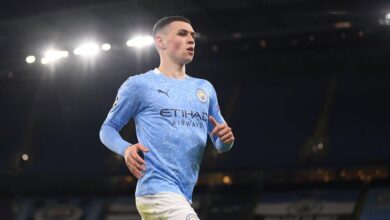Justin Fields embodies the NFL’s future, so why is his draft stock slipping?

[ad_1]

With the draft less than a month away Justin Fields, once viewed as the consensus second-best quarterback in the class, is now on the slide. The nonsense swirling around the Ohio State star is disturbing, but it shouldn’t be surprising.
Clemson’s Trevor Lawrence will go off the board to the Jacksonville Jaguars with the first overall pick in this month’s draft. BYU’s Zach Wilson is expected to go second to the Jets – a pick that was all but confirmed by the team’s general manager on Monday. With the third pick, the 49ers, who acquired the selection thanks to an expensive trade with the Dolphins, are expected to snap up Alabama quarterback Mac Jones. Fields, meanwhile, has slipped into a jumble of quarterbacks vying for the fourth spot.
As with any slide, innuendo and narratives take over. One is that Fields cannot read the field – or, more accurately, that he cannot move from his first read through a full-field progression. The other is that he doesn’t work hard enough. Then there’s the insinuation he isn’t competitive enough. Last week, ESPN analyst Dan Orlovsky raised some of those concerns: “I have heard that he is a last-guy-in, first-guy-out type of quarterback,” Orlovsky told the Pat McAfee Show. “Like, not the maniacal work ethic … Where is his desire to be a great quarterback?”
Orlovsky has since been at pains to point out that he was passing along what others had said about Fields rather than sharing his personal opinion. But such negative connotations have become part of the ingrained lexicon when it comes to discussing black quarterback prospects. It was only three years ago that Bill Polian, a respected personnel executive and member of the Pro Football Hall of Fame, suggested that Lamar Jackson should switch positions coming out of college, a practice commonly employed by teams in the pro and college ranks over decades to move black quarterbacks to what were perceived as more athletically inclined positions.
Related: There’s an unfamiliar feeling around the New England Patriots: desperation
“If you listen to the critiques of black quarterbacks v white quarterbacks,” draft analyst Bucky Brooks recently told NFL.com, “there’s a different standard applied to blacks.”
A 2019 Washington Post study found substantial racial differences in the language used to describe quarterback prospects — differences that are consistent with established racial stereotypes. White quarterbacks are more likely to be discussed in terms of the intangibles. They are smart. They display intelligence. They are leaders. They command the huddle.
Minority quarterbacks, by contrast, are more likely to be assessed in terms of their physical traits. There is talk of difficulties picking up the playbook or a querying of their work ethic and intellect. And this in an era when Patrick Mahomes, Lamar Jackson, and Cam Newton have won MVPs and Russell Wilson has cemented his place as a perennial top-five quarterback.
Yet while the top end of the NFL’s most important position has seen a cultural revolution, that has failed to trickle down to the back end of rosters. And nor has it stopped quarterback prospects being framed with the same old, tired stereotypes. It is an issue that has shifted from the conscious to the subconscious.
Fields’ head coach at Ohio State, Ryan Day, was quick to dismiss the idea that the quarterback lacks the hunger or desire to succeed. The criticism, Day said, has “gotten a little reckless.” But that the coach would even have to mount such a defense for a quarterback with Fields’ resume is a problem.
Fields had more than 5,000 yards passing yards, threw 63 touchdowns to nine interceptions, averaged just shy of 11-yards per pass attempt, and tacked on another 15 touchdowns with his legs during his two years as Ohio State’s starter – and that despite playing just eight games in the second season due to the coronavirus pandemic.
Add to that: he threw for six touchdowns against Clemson’s vaunted defense in the College Football Playoff semi-final despite fracturing his ribs earlier in the game; he threw for as many touchdowns as incompletions while leading the Buckeyes to a win.
Add to that: Fields grades out first among all college quarterbacks since 2019 on throws beyond the first read, per ProFootballFocus.
Add to that: according to former Jets quarterback and current ESPN analyst Mark Sanchez, Fields had the highest score in the history of a well-publicized aptitude test – a test that has been issued to more than 6,500 professional athletes and measures their ability to process, retain and recall information.
Fields’s slide down the draft becomes all the more curious when you consider the trend of the league.
The NFL is no longer the league of the Manning brothers or Philip Rivers or Drew Brees. Dropback, rhythm passers are on their way out – except for Tom Brady; Brady remains invincible. The NFL is now the league of Mahomes, Jackson, Wilson, and Josh Allen. It’s about quarterbacks who can run and create off-script as well as deliver plays on time and in rhythm in order to keep some of the melodic elements of the pro-style passing game. It’s no longer an either-or – a dropback passer or a dual-threat (a code word for a runner). The league is looking for the total package: it is looking for the next Aaron Rodgers or Dak Prescott.
As the spread-option and its principles become increasingly prevalent (they are now indulged by even the self-confessed dinosaurs among the league’s executives), those who ran such a system in college should, it would stand to reason, be increasingly valuable.
When Kyler Murray was selected first overall by the Cardinals, it felt like a culture shift. From Jackson slipping to the 30th pick and being hit with questions about whether he should change his position to Murray, a 5ft 10in poster child of the pace-and-space era, being selected first overall in the span of 12 months.
The Cardinals were all in on the modern movement, though. They hired Kliff Kingsbury, a darling of the so-called air-raid movement, and turned the whole organization into a souped-up version of a college program.
Some teams are still just dabbling with the principles or fashioning their own variants – a valid tactic. The 49ers, for instance, continue to run a hybrid blend of things that Kyle Shanahan and his father have used to astounding success since the early 90s, paired with some of the college-style ideas that are now ubiquitous across the league.
Both Fields and Jones have experience running similar dual-style systems in college. The Niners are expected to place their chips on Jones, who plays as more of a see-it-sling-it type quarterback than an on-the-move creator.
Jones could be good. He could be bad. Fields could be good. He could be bad. Yet the former profiles as a quarterback from the past and Fields profiles as a quarterback who signifies the present and the future. Who would you choose?
[ad_2]
Source link






